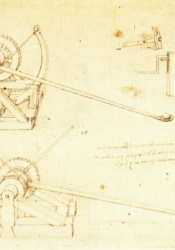Leonardo da Vinci’s Catapult
Within the time of the Renaissance, significant revolutionary developments in the applications, properties, and laws of universal sciences were sought and attempted to be explained. As such, in specifically analyzing the mechanical properties of systems and the universal laws of motion, leading Renaissance man, Leonardo da Vinci, sought to investigate his fascination with motion by exploring the principle functionalities and fundamental qualities of moving apparatuses. Believing that both machines and humans were systems designated to move, da Vinci experimentally evaluated physical phenomena and visually depicted his theoretical models within his prized and unpublished, Codex Atlanticus, the principal manuscript collections that pertain to his designed machines and mechanisms. Within his investigations of motion, he was noted for investigating the frictional and angular properties of what Aristotle had once coined as “simple machines,” such as inclined planes, levers, screws, pulleys, axels, and wheels, but was notably distinct in further attempting to improve complex machines with his new understandings of the principles of motion. By essentially deriving and comprehending Newton’s First Law of motion, with his exception being his ignorance regarding the properties of gravity, da Vinci was able to utilize his preliminary knowledge of torque, tension forces, and angular motion to reimagine and theoretically explore an improved and ideal catapult design.
By the Renaissance era, catapults had already established themselves as one of the most valued weapons of the Eastern Hemisphere, and although gunpowder had become a new staple of warfare mechanics, da Vinci understood that this new substance was not completely reliable during his time and led him to attempt to innovatively explore his studies of motion while proposing innovative and improved designs for the previously created catapult. Thus, after settling in Milan and working as a Renaissance defense contractor under his patron, Il Moro, da Vinci worked diligently in drafting mechanical military and designs that explored his idealized properties of complex technical processes, which included the catapult. Da Vinci is known to have developed two designs, the single and double arm system, for his ideal catapult, each of which utilized what is referred to as the leaf-spring system to optimize the weapon’s accuracy and power. Da Vinci’s new designs distinguishably improved the preceding catapults by incorporating a rotating drum rather than a bow and draw-string. Regarding the motion of the launch arm, the systems were said to have increased rotational velocity and an optimization of angular momentum using bending leaf spring sections which would provide an overexerted physical force upon the release of the systems activation mechanism. Arguably the most imperative aspect to the functionality of da Vinci’s catapult is the leaf spring system which is a pliable, flexible beam constructed though the layered stacking of sheets of metal or laminated wood. When constructing these leaf springs, it is imperative that, as the layers are stacked, their length decreases linearly to improve the density of material in the beam’s center, making the edges of the leaf spring more flexible. With this design, when assembled, the leaf spring apparatus can achieve greater curvature and thus more effective propellant power.
The primary distinction between the single and the double arm catapult designs is the incorporation of pawl and rachet system and worm gear system. In analyzing the single arm catapult, the weapon’s pawl and rachet system would secure the launch arm to its lowered position by situating grooves of a flywheel to the arm’s tines while bending the singular leaf spring. This was imperative in avoiding accidental ejections and unwanted injuries common with previously developed catapults. Furthermore, the double arm system would use a winding, worm gear system that would rely on two leaf springs to create torsion tension while gradually positioning the throwing arm to a lowered position. The use of two leaf arms unfolding outwards had the cumulative effect of distributing immense and significant power to the launch arm thereby applying a large centrifugal acceleration to the projectile relative to the rotating launch arm.
With this illustrative depiction of utilizing rotational motion to optimize the launching mechanisms of the familiar catapult, da Vinci was said to have created the most effective and mechanically efficient catapult ever invented. This system, if scaled correctly, was projected to fire objects to a range of approximately one quarter mile. However, the design contained a plethora of disadvantages that prevented its ultimate creation. For example, the construction of steel leaf springs would have been extremely cost inefficient due to the expensive nature of acquiring multiple steel plates less than a millimeter thick, mortars were simultaneously developed by da Vinci which created a greater force of impact to enemy armies and were more cost-effective, and the extreme velocity applied by the contorting leaf springs would have eventually decreased the structural rigidity of these springs and resulted in an eventual snapping that could have resulted in catapult operators’ deaths or significant injuries. Nevertheless, da Vinci’s catapult continues to represent the culmination of his infatuation with investigating the physical properties of perpetual motion devices.
Sources:
Catapult Model: Leonardo da Vinci’s Catapult Model. (n.d.). Retrieved May 6, 2019, from http://www.leonardodavincisinventions.com/leonardo-da-vinci-models/leona...
Hucbald, H. (2007, April 14). A Leonardo da Vinci Leaf Spring Catapult. Retrieved May 6, 2019, from http://www.hucbald.ramst.ca/articles/leonardo_catapult.html
Isaacson, W. (2018). Leonardo Da Vinci. New York: Simon & Schuster Paperbacks.
Leonardo Da Vinci's Life: Da Vinci’s Catapult. (n.d.). Retrieved May 6, 2019, from https://www.davincilife.com/catapult.html
Moon, F. C. (2016). Machines of Leonardo Da Vinci and Franz Reuleaux: Kinematics of Machines from the Renaissance to the 20th century. Place of publication not identified: SPRINGER.

